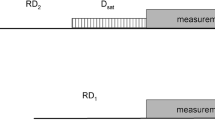Abstract
Proton-proton relaxation rate constants depend on the angle between the internuclear vector and the principal axis of rotation in symmetric top molecules. It is possible to determine to rotational correlation times of the equivalent ellipsoid for DNA fragments from a knowledge of the axial ratio and the cross-relaxation rate constant for the cytosine H6-H5 vectors. The cross-relaxation rate constants for the cytosine H6-H5 vectors have been measured in the 14-base-pair sequence dGCTGTTGACAATTA.dTAATTGTCAACAGC at four temperatures. The results, along with literature data for DNA fragments ranging from 6 to 20 base pairs can be accounted for by a simple hydrodynamic equation based on the formalism of Woessner (1962). The measured cross-relaxation rate constant is independent of position in the sequence and is consistent with the absence of large amplitude internal motions on the Larmor time scale. All the data can be described by a simple hydrodynamic model, which accounts for the rotational anisotropy of the DNA fragments and allows the correlation time for end-over-end tumbling to be determined if the approximate rise per base pair is known. This is the correlation time that dominates the spectral density functions for internucleotide vectors and is significantly different from that calculated for a sphere of the same hydrodynamic volume for fragments containing more than about 14 base pairs. This method therefore allows NOE intensities used for structure calculation of nucleic acids to be treated more rigorously.
Similar content being viewed by others
References
Borgias BA, James TL (1988) COMATOSE, a method for constained refinement of macromoleculer structure based on twodimensional nuclear Overhauser enhancement spectra. J Magn Reson 79:493–512
Cantor CR, Schimmel PR (1980) Biophysical chemistry, part III, chap 10. Freeman, San Francisoc
Eimer W, Williamson JR, Boxer SG, Pecora R (1990) Characterisation of the overall and internal dynamics of short oligonucleotides by depolarised dynamic light scattering and NMR relaxation measurements. Biochemistry 29:799–811
Forster MJ, Lane AN (1990) 31P NMR relaxation measurements of the phosphate backbone of a double-stranded hexanucleotide in solution: determination of the chemical shift anisotropy. Eur J Biophys 18:347–355
Hogan ME, Jardetzky O (1979) Internal motions in DNA. Proc Natl Acad Sci 76:6341–6345
Hogan ME, Jardetzky O (1980) Internal motions in deoxyribonucleic acid II. Biochemistry 19:3460–3468
Lane AN (1989) NMR assignments and temperature-dependent conformational transitions of a mutant trp operator-promoter in solution. Biochem J 259:715–724
Lane AN (1990) The determination of the conformational properties of nucleic acids in solution from NMR data. Biochim Biophys Acta 1049:189–204
Lane AN, Forster MJ (1989) Determination of internal dynamics of deoxyriboses in the DNA hexamer d(CGTACG)2 by 1H NMR. Eur Biophys J 17:221–232
Lane AN, Lefèvre J-F, Jardetzky O (1986) A method for evaluating correlation times for tumbling and internal motions in macromolecules using cross relaxation rate constants from proton NMR spectra. J Magn Reson 66:201–218
Lefèvre J-F, Lane AN, Jardetzky O (1987) Solution structure of the Trp operator of Escherichia coli determined by NMR. Biochemistry 26:5076–5090
Lipari G, Szabo A (1981) Nuclear magnetic resonance relaxation in nucleic acid fragments: models for internal motion. Biochemistry 20:6250–6256
Lipari G, Szabo A (1982) Model-free approach to the interpretation of nuclear magnetic resonance relaxation in macromolecules. J Am Chem Soc 104:4546–4558
McCammon JA, Harvey SC (1987) Dynamics of proteins and nucleic acids. Cambridge University Press, Cambridge
Nerdal W, Hare DR, Reid BR (1989) Solution structure of the EcoR1 DNA sequence: refinement of NMR-derived distance geometry structures by NOESY spectrum back-calculations. Biochemistry 28:10008–10021
Nilges M, Clore GM, Gronenborn AM, Brünger AT, Karplus M, Nilsson L (1987a) Refinement of the solution structure of the DNA hexamer 5′d(GCATGC)2: combined use of NMR and restrained molecular dynamics. Biochemistry 26:3718–3733
Nilges M, Clore GM, Gronenborn AM, Piel N, McLaughlin LW (1987b) Refinement of the solution structure of the DNA decamer 5′d(CTGGATCCAG)2: combined use of NMR and restrained molecular dynamics. Biochemistry 26:3735–3744
Patel DJ, Shapiro L, Hare D (1987) Nuclear magnetic resonance studies and distance geometry studies of DNA structures in solution. Q Rev Biophys 20:35–112
Tirado MM, Garcia de la Torre J (1979) Translational friction coefficients of rigid, symmetric top macromolecules. Application to circular cylinders. J Chem Phys 71:2581–2587
Tirade, MM, Garcia de la Torre J (1980) Rotational dynamics of rigid, symmetric top macromolecules. Application to circular cylinders. J Chem Phys 73:1986–1993
Wilbur DW, DeFries T, Jonas J (1976) Diffusion in compressed liquid heavy water. J Chem Phys 65:1783–1788
Woessner DE (1962) Nuclear spin relaxation in ellipsoids undergoing rotational Brownian motion. J Chem Phys 37:647–654
Author information
Authors and Affiliations
Additional information
Offprint requests to: A.N. Lane
Rights and permissions
About this article
Cite this article
Birchall, A.J., Lane, A.N. Anisotropic rotation in nucleic acid fragments: significance for determination of structures from NMR data. Eur Biophys J 19, 73–78 (1990). https://doi.org/10.1007/BF00185089
Received:
Accepted:
Issue Date:
DOI: https://doi.org/10.1007/BF00185089




